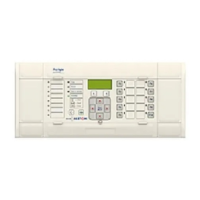(GS) 3-
1.8.3.3 Hotkey menu navigation
HOT KEY MENU
EXIT
Description
MiCOM P741
HO TKEY
<USER 32
STG GP>
SETTING GROUP 1
SELECT
<MENU
USER 01>
NXT GRP
CONTROL INPUT 1
ON
<STG GP
USER 02>
EXIT
CONTROL INPUT 32
ON
<USER 31
MENU>
EXIT
SETTING GROUP 2
SELECT
<MENU
USER 01>
NXT GRP
SETTING GROUP 2
SELECTED
<MENU
USER 01>
CONTROL INPUT 1
ON
<MENU
USER 02>
CONTROL INPUT 1
EXIT
<MENU
USER 02>
OFF
Confirmation
screen
displayed for
2 seconds
Confirmation
screen
displayed for
2 seconds
Default Display
NO TE: <<EXIT>> K ey returns
the userto the Hotkey
MenuScreen
P3915ENa
FIGURE 8: HOTKEY MENU NAVIGATION
1.8.4 Password entry
When entry of a password is required the following prompt will appear:
Enter password
**** Level 1
Note: The password required to edit the setting is the prompt as shown
above.
A flashing cursor will indicate which character field of the password may be changed. Press
the
and keys to vary each character between A and Z. To move between the
character fields of the password, use the
and keys. The password is confirmed by
pressing the enter key
. The display will revert to ‘Enter Password’ if an incorrect
password is entered. At this point a message will be displayed indicating whether a correct
password has been entered and if so what level of access has been unlocked. If this level is
sufficient to edit the selected setting then the display will return to the setting page to allow
the edit to continue. If the correct level of password has not been entered then the password
prompt page will be returned to. To escape from this prompt press the clear key
.
Alternatively, the password can be entered using the ‘Password’ cell of the ‘System data’
column.
For the front panel user interface the password protected access will revert to the default
access level after a keypad inactivity time-out of 15 minutes. It is possible to manually reset
the password protection to the default level by moving to the ‘Password’ menu cell in the
‘System data’ column and pressing the clear key
instead of entering a password.
1.8.5 Reading and clearing of alarm messages and fault records

